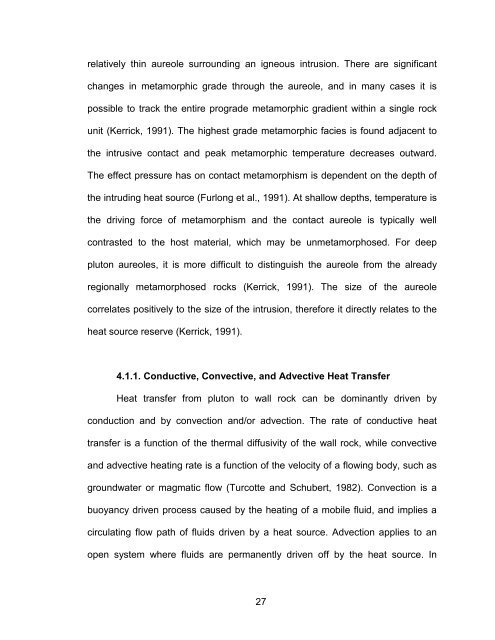Create successful ePaper yourself
Turn your PDF publications into a flip-book with our unique Google optimized e-Paper software.
elatively thin aureole surrounding an igneous intrusion. There are significant<br />
changes in metamorphic grade through the aureole, and in many cases it is<br />
possible to track the entire prograde metamorphic gradient within a single rock<br />
unit (Kerrick, 1991). The highest grade metamorphic facies is found adjacent to<br />
the intrusive contact and peak metamorphic temperature decreases outward.<br />
The effect pressure has on contact metamorphism is dependent on the depth <strong>of</strong><br />
the intruding heat source (Furlong et al., 1991). At shallow depths, temperature is<br />
the driving force <strong>of</strong> metamorphism and the contact aureole is typically well<br />
contrasted to the host material, which may be unmetamorphosed. For deep<br />
pluton aureoles, it is more difficult to distinguish the aureole from the already<br />
regionally metamorphosed rocks (Kerrick, 1991). The size <strong>of</strong> the aureole<br />
correlates positively to the size <strong>of</strong> the intrusion, therefore it directly relates to the<br />
heat source reserve (Kerrick, 1991).<br />
4.1.1. Conductive, Convective, and Advective Heat Transfer<br />
Heat transfer from pluton to wall rock can be dominantly driven by<br />
conduction and by convection and/or advection. The rate <strong>of</strong> conductive heat<br />
transfer is a function <strong>of</strong> the thermal diffusivity <strong>of</strong> the wall rock, while convective<br />
and advective heating rate is a function <strong>of</strong> the velocity <strong>of</strong> a flowing body, such as<br />
groundwater or magmatic flow (Turcotte and Schubert, 1982). Convection is a<br />
buoyancy driven process caused by the heating <strong>of</strong> a mobile fluid, and implies a<br />
circulating flow path <strong>of</strong> fluids driven by a heat source. Advection applies to an<br />
open system where fluids are permanently driven <strong>of</strong>f by the heat source. In<br />
27
















